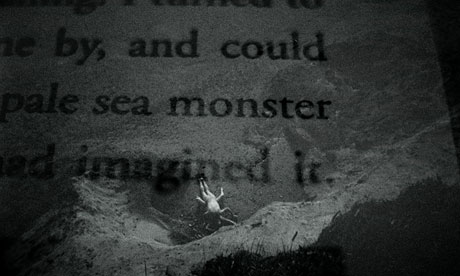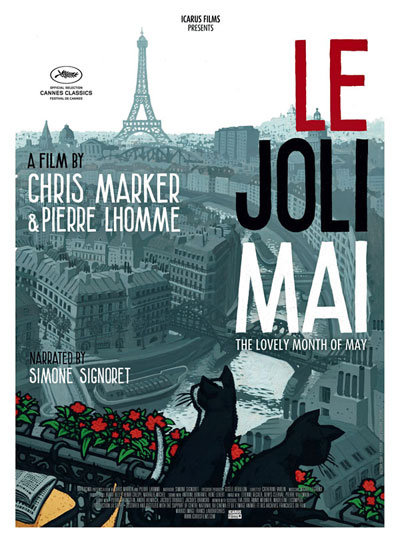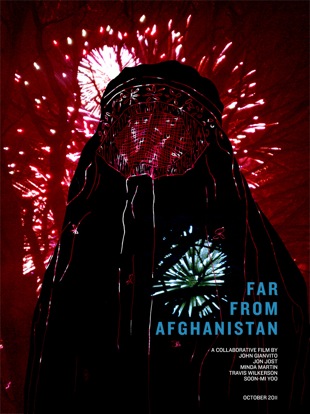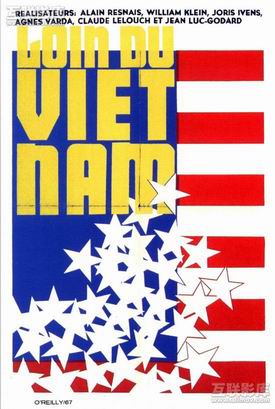Tagged: Sight & Sound
Thought in Action: The Art of the Essay Film – Elements of the Essay Film #essayfilm
This video essay from Fandor was made for the Thought in Action: The Art of the Essay Film season at the BFI in August 2013. It’s creator Kevin B Lee was commissioned by the BFI to explore the somewhat indefinable genre essay film. Lee says “I spent several weeks reflecting on what the essay film is. This led to a video essay and text published via the BFI’s magazine Sight & Sound that aimed to argue for what true value this as-yet loosely-defined mode of filmmaking could bring to a world that is already drowning in media. Using the video essay to take a polemical stance was a galvanizing experience for me, as it clarified a great deal of my own sense of purpose in being a film critic in a landscape where critical opinions are abundantly available. This video features the work of Santiago Alvarez, Jean-Luc Godard, Alain Resnais and many others”.
Vagrancy and drift: the rise of the roaming essay film
Freedom and possibility … a still from Grant Gee’s Patience (After Sebald) from 2011
by Sukhdev Sandhu. The Guardian, Saturday 3 August 2013
For years the essay film has been a neglected form, but now its unorthodox approach to constructing reality is winning over a younger, tech-savvy crowd.
For a brief, almost unreal couple of hours last July, in amid the kittens and One Direction-mania trending on Twitter, there appeared a very surprising name – that of semi-reclusive French film-maker Chris Marker, whose innovative short feature La Jetée (1962) was remade in 1995 as Twelve Monkeys by Terry Gilliam. A few months earlier, art journal e-flux staged The Desperate Edge of Now, a retrospective of Adam Curtis‘s TV films, to large audiences on New York’s Lower East Side. The previous summer, Handsworth Songs (1986), an experimental feature by the Black Audio Film Collective Salman Rushdie had once attacked as obscurantist and politically irrelevant, attracted a huge crowd at Tate Modern when it was screened shortly after the London riots.
Marker, Curtis, Black Audio: all have made significant contributions to the development of an increasingly powerful and popular kind of moving-image production: the essay film. Currently being celebrated in a BFI Southbank season entitled The Art of the Essay Film – curated by Kieron Corless of Sight and Sound magazine – it’s an elusive form with an equally elusive and speculative history. Early examples proposed by scholars include DW Griffith’s A Corner in Wheat (1909), Dziga Vertov’s Man with a Movie Camera (1929) and Jean Vigo‘s A Propos de Nice(1930), but some of its animating principles were identified in a key text, “The Film Essay” (1940) by the German artist Hans Richter, which called for documentaries “to find a representation for intellectual content” rather than merely “beautiful vistas”.
Essay films, unlike conventional documentaries, are only partly defined by their subject matter. They tend not to follow linear structures, far less to buttonhole viewers in the style of a PowerPoint presentation or a bullet-pointed memo; rather, in the spirit of Montaigne or even Hazlitt, they are often digressive, associative, self-reflexive. Just as the word essay has its etymological roots in the French “essai” – to try – essay film-makers commonly foreground the process of thought and the labour of constructing a narrative rather than aiming for seamless artefacts that conceal the conceptual questions that went into their making. Incompletion, loose ends, directorial inadequacy: these are acknowledged rather than brushed over.
Aldous Huxley once claimed an essay was “a literary device for saying almost everything about almost anything”. Essay films exploit this freedom and possibility, exulting in the opportunity to avoid the hermetic specialisation that characterises much academic scholarship, and to draw on ethnography, autobiography, philosophy and art history. A case in point is Otolith I (2003) by the Turner prize-nominated Otolith Group, whose co-founder Kodwo Eshun will deliver a keynote speech at BFI Southbank: it uses the mass demonstrations against the second Iraq conflict in London as an occasion to think about political collectivity, and deploys an elusive, eerily compelling compound of science fiction, travelogue, epistolary writing and leftist history to do so.
This roaming or tentacular approach to structure can be seen as a kind of territorial raid. Or perhaps essay film-makers are aesthetic refugees fleeing the austerities and repressions of dominant forms of cinema. It’s certainly striking how many essay films grapple with landscape and cartography: Patrick Keiller‘s London (1994) uses a fixed camera, a droll fictional narrator named Robinson and near-forensic socio-economic analysis to explore the “problem” of England’s capital; Los Angeles Plays Itself (2003) is an extraordinary montage film by Thom Andersen in which, sampling almost exclusively (unlicensed) clips from 20th-century cinema and with drily damning commentary, he critiques representations of his home city.
Essay films sometimes exhibit a quality of vagrancy and drift, as if they are not wholly sure of what they want to say or of the language they need to say it, which may stem from their desire to let subject matter determine – or strongly influence – filmic form. Here, as in the frequent willingness to blur the distinction between documentation and fabulation, the essay film has much in common with “creative non-fiction”. The literary equivalents of Hartmut Bitomsky, director of a mysterious investigation of dust, and Patricio Guzmán whose Nostalgia for the Light (2010) draws on astronomy to chart the poisonous legacies of Pinochet‘s coup d’etat in Chile, are writers such as Sven Lindqvist, Eduardo Galeano and Geoff Dyer. Perhaps it’s no coincidence that one of the most celebrated modern creative non-fiction authors was the subject of an equally ruminative, resonant essay film – Grant Gee’s Patience (After Sebald) (2011).
Essay film-makers – among them the Dziga Vertov Group (whose members included Jean-Luc Godard and Jean-Pierre Gorin) or the brilliant Santiago Álvarez – are often motivated by political concerns, but their work is never couched in the language of social realism or the journalistic dispatch. It is never purely utilitarian and is more likely to offer invitations to thought than clarion calls for action: Godard and Gorin’s Letter to Jane (1972) decodes at length a single still photograph of Jane Fonda on a trip to Vietnam; Black Audio Film Collective’sHandsworth Songs proposes that behind the blaring headlines of riot footage in the British media there lie the “ghosts of other stories”; Harun Farocki‘s Images of the World and Inscription of War (1988) explores the interplay of technology, war and surveillance. Essay films can be playful, but even when they are serious – as these three are – their approaches, at once rigorous and open-ended, are thrilling rather than pedagogic.
Just as literary critics used to lament that critical theory was taken more seriously in France than in the UK, the renown of essayists such as Marker, Godard and Agnès Varda (whose The Gleaners and I, a witty and moving meditation on personal, technological and socio-political obsolescence is a masterpiece) has served to obscure the range and history of British contributions to the genre: the sonically exploratory, surrealism-tinged likes of Basil Wright’s Song of Ceylon (1934) and Humphrey Jennings’s Listen to Britain (1942); Mike Dibb and John Berger’s Ways of Seeing (1972), which bears the imprint of Bertolt Brecht and Walter Benjamin; BS Johnson’s self-deconstructing Fat Man on a Beach (1973); Derek Jarman‘s exquisitely crepuscular Blue (1992), in which the director talks about and through his fading eyesight; and Marc Karlin’s resonant disquisition about cultural amnesia in For Memory (1986).
Some of these films started life on television, but these days it is the gallery sector that is more likely to commission or screen essay films, which are attracting ever more sizable audiences, especially younger people who have been weaned on cheap editing software, platforms such as Tumblr and the archival riches at YouTube and UbuWeb. Visually literate and semiotically savvy, they have tools – conceptual as well as technological – not only to critique and curate (moving) images, but to capture and assemble them. Having grown up in the era of LiveJournal and Facebook, they are also used to experimenting with personal identity in public; RSS feeds and news filters have brought them to a point where the essay film’s fascination with investigating social mediation and the construction of reality is second nature. It could well be that the essay film – for so long a bastard form, an unclassifiable and barely studied hybrid, opaque even to cinephiles – is ready to come into its own.
Chris Marker: Marc 2
In a post last year, I traced the lost history of Marc Karlin’s collaborations with Chris Marker. It is over a year since Marker’s death and in tribute, stirred by the BFI’s Film Essay season in August, here is a collection of Marker related videos. Firstly, a visual essay from Criterion exploring the soundscape of Chris Marker’s 1962 landmark La Jetée, written by Michael Koresky of Reverse Shot.
Codirected by Frank Simeone and John Chapman, Junkopia was filmed at the Emeryville Mudflats outside of San Francisco while Chris Marker was also shooting the Vertigo sections of Sans Soleil.
Toute la mémoire du monde (1956) is a 20 minute bout of archive fever administered by Alain Resnais. Resnais takes us behind the scenes of the Bibliothèque nationale de France in Paris, conceiving a key theme of the film essayist; the fragility of memory and the need to remember. In the opening credits Marker, a man of many aliases, is introduced as Chris the Magic Marker – that most democratic of public writing tools as Finn Burton puts it in Future Anterior,
That Resnais documentary follows one book into the Bibliothèque Nationale and thence into the hands of a reader, and the book happens to be one of the Petite Planète series of travel books, a series founded and edited (1954–58) by Marker. ‘Not a guidebook,’ Marker promised, ‘not a history book, not a propaganda brochure, not a traveller’s impressions, but instead equivalent to the conversation we would like to have with someone intelligent and well-versed in the country that interests us.’ Perhaps, then, something like the letters Sandor Krasna sends from his travels to his unnamed correspondent (voiced with limpid calm by Alexandra Stewart) in Sans-soleil (1983). Marker did much of the graphic design and layout work for the series as well, and every cover was a different picture of a woman, some looking away and lost in their own thoughts, others gazing into the camera, reserved and enigmatic. In Remembrance of Things to Come (2001), Alexandra Stewart, speaking again on behalf of Marker, says of the work of Denise Bellon, ‘Being a photographer means not only to look but to sustain the gaze of others.’ ‘Have you heard of anything stupider’, she says, quoting a letter of Krasna’s from Fogo in the Cape Verde islands, ‘than to say to people, as they teach in film schools, not to look at the camera?’ There is a woman, gazing slightly off-camera, on the cover of the Petite Planète edition (#25) that has arrived for cataloging in the Resnais film. Her hair is in an elegant black bob, she wears a simple black garment; the book, its title announces, is a traveller’s guide to Mars. She is perhaps the first of Marker’s many characters who address us, unexpectedly, from the future. They look back on our present moment and, in doing so, transform it, as we now transform the past, our memories, our recordings. (‘I wonder how people remember things who don’t film, don’t photograph, don’t tape.’)
In April Icarus Films announced its acquisition of all North American distribution rights to Chris Marker and Pierre Lhomme’s landmark 1963 film Le joli mai. This film had been unavailable for many years and it is now newly restored. It will be screened at several major film festivals and premiered in New York at Film Forum on September 13, 2013, presented in DCP, made from a new 2K scan. The restoration work on Le joli mai was done according to the wishes of Chris Marker and supervised by Pierre Lhomme, the film’s cinematographer and co-director. First off is Lhomme commenting on the restoration process, followed by the new trailer.
LE JOLI MAI is a portrait of Paris and Parisians shot during May 1962. It is a film with several thousand actors including a poet, a student, an owl, a housewife, a stockbroker, a competitive dancer, two lovers, General de Gaulle and several cats. Filmed just after the March ceasefire between France and Algeria, LE JOLI MAI documents Paris during a turning point in French history: the first time since 1939 that France was not involved in any war. Icarus Films
In Sight & Sound’s glorious celebration of the life and work of Chris Marker last year (Vol. 22 Issue 10 Oct 2012), a number of filmmakers, including Jem Cohen, Thom Anderson, Patrick Keiller, Chris Petit, Sarah Turner and Kodwo Eshun, paid tribute to the man. The US filmmaker John Gianvito proclaimed that any filmmaker who has ventured into the film essay territory in the past 55 years owes a great debt to Marker, and befittingly includes Marc Karlin. Introduced to Karlin’s work by Marker, Gianvito states Karlin is in need of the same recovery Marker bestowed the Soviet filmmaker Alexander Medvedkin.
John Gianvito’s most recent ouput is the collective film Far From Afganistan (2012), made with filmmakers Travis Wilkerson, Jon Jost, Minda Martin and Soon-Mi Yoo. The film is clearly inspired by Loin Du Vietnam (Far from Vietnam) (1967), a collaboration between Alain Resnais, Claude Lelouch, Jean-Luc Godard, William Klein, Joris Ivens, and Agnès Varda, conceived as an outcry against the Vietnam War. Marker edited together William Klein’s films of pro- and anti-war protests in New York, Joris Ivens’ own North Vietnam footage; additional material by Agnès Varda and Claude Lelouch and Resnais and Godard’s self-contained sequences. From this prototype, Far From Afghanistan mixes fictional narrative, found footage and reportage in response to a protracted war that remains far from the collective consciousness. Here are both trailers, side by side. (Look out for Marker’s owl in Far From Afghanistan).
Next is a video postcard Agnes Varda made for her friend Chris Marker presented at the Rencontres de la Photographie in Arles in 2011 and her glimpse inside Marker’s studio. Marc Karlin too describes Marker’s studio upon a visit around the editing period of Le Fond de l’air est rouge (1977).
“Chris had a garage, a huge studio with drainpipes all across it. It was vast, and he put these little rolls of films all along the drainpipes, and then divided it onto countries, so you had Columbia, Peru, Cuba, Africa and so on. I entered this garage to find all these films from all these countries: the whole world was there. Right at the end there was Chris Marker on a platform with his editing table, and he looked like God. You had to walk past these films to reach him and sit down”.
Last year in an article written for Sight & Sound, Patrico Guzman recalled his first meeting with Marker and recounts his debt of gratitude that he owes to his mentor while filming Because The First Year. Nine years before their first meeting, Guzman and Marker collaborated, from a distance (Guzman with camera and Marker on script) on Joris Iven’s film …A Valparaíso (1962).
In 1962 Joris Ivens was invited to Chile for teaching and filmmaking. Together with students he made … A Valparaiso, one of his most poetic films. Contrasting the prestigious history of the seaport with the present the film sketches a portret of the city, built on 42 hills, with its wealth and poverty, its daily life on the streets, the stairs, the rack railways and in the bars. Although the port has lost its importance, the rich past is still present in the impoverished city. The film echoes this ambiguous situation in its dialectical poetic style, interweaving the daily life reality (of 1963) with the history of the city and changing from black and white to colour, finally leaving us with hopeful perspective for the children who are playing on the stairs and hills of this beautiful town. ivens.nl
And finally… a glimpse of Christian François Bouche-Villeneuve, alias Sandor Krasna, alias Hayao Yamaneko, alias Kosinski, alias Guillaume-en-Egypte, alias Sergei Murasaki, alias Chris Marker…
Further Reading:
http://strangewood.tumblr.com/tagged/Chris%20Marker
http://www.fandor.com/blog/daily-chris-marker-1921-2012
http://www.filmcomment.com/article/chris-marker-the-truth-about-paris
http://www.criterion.com/current/posts/2246-cinematography-by-pierre-lhomme




